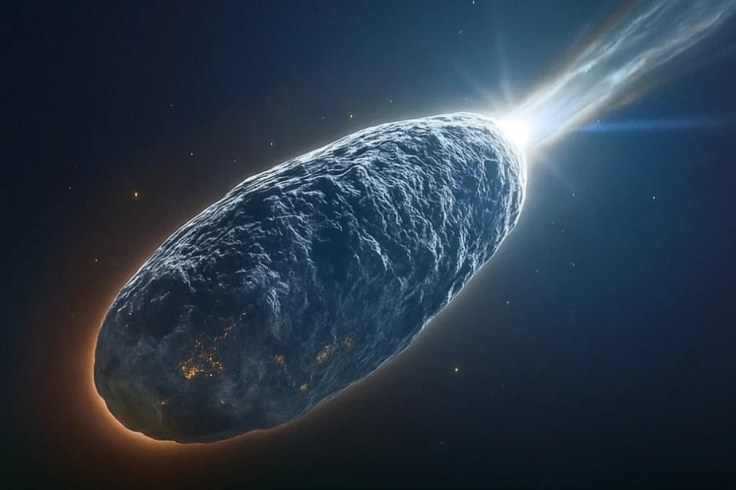Avi Loeb Calculates 3I/ATLAS is One in 100 Million Chance of Being Natural
Its massive size and unusual, tightly aligned trajectory present an extreme anomaly

When an interstellar object cruises through our solar system, scientists naturally scrutinise its nature. But for one of these visitors, the unusual comet 3I/ATLAS, Harvard physicist Avi Loeb has crunched the numbers, arriving at a seemingly impossible conclusion: the likelihood of its shape being purely natural is astronomically small.
Recently, a magnificent, wide-field picture of the interstellar object 3I/ATLAS was shared on the British Astronomical Association (BAA) website, captured by Frank Niebling and Michael Buchner. The image, which stacks a sequence of five three-minute exposures, was taken using two telescopes (TEC 140/f5 and ASI 6200MM) between 5:08 and 5:22 UT on 9 November 2025.
Loeb's Observations on the Object's Tail
In his most recent piece on Medium, Loeb highlighted that the picture displays two anti-tail streaks, extending up to 10 arcminutes toward the Sun. This feature is also accompanied by a longer, focused outflow, which stretches away from the Sun to an angular distance of 30 arcminutes — a size roughly equal to the apparent width of either the Sun or the Moon.
At the current distance of 326 million kilometres separating 3I/ATLAS from Earth, these angular measurements translate to actual physical sizes: 0.95 million kilometres for the anti-tail streaks facing the Sun, and 2.85 million kilometres for the outflow trailing away from the Sun.
This vast physical dimension is approximately a thousand times greater than the size of the bright coma, or halo, visible around 3I/ATLAS in the Hubble Space Telescope image from 21 July 2025, which was shared on IOPscience.
READ MORE: Avi Loeb Warns Speed Boost on 3I/ATLAS Requires Vast Power — Unknown Force at Work?
READ MORE: Daniel Liszt and Avi Loeb Join Alex Jones as He Claims CIA/Mossad Shaping 3I/ATLAS Story
Future Observations and Closest Approach
This multi-jet structure makes the object an outstanding candidate for upcoming observations using the Hubble and Webb telescopes, especially since 3I/ATLAS is due to reach its nearest point to Earth on 19 December 2025.
Its shortest distance from our planet will be 269 million kilometres, a range that is approximately a hundredfold greater than the size of the outflow pattern visible in the pictures taken today.
It's improbable, therefore, that instruments on Earth-based satellites designed to collect particles will be able to capture material from these outflows. The same restriction applies to the particle detectors aboard NASA's Juno spacecraft, currently orbiting Jupiter (as detailed on arXiv). Juno is scheduled to examine 3I/ATLAS on 16 March 2026 from a range of 53 million kilometres, which is ten times greater than the size of the current jet pattern.
Similarly, the ESA's Juice probe, which is currently heading towards Jupiter, is sixty-four million kilometres away from 3I/ATLAS right now and cannot intersect these outflows.
Outflow Velocity and Ejection Time
For a natural comet, the velocity of the outflow from the jets is anticipated to be just 0.4 kilometres per second. This speed is comparable to the speed of sound in the gas at the current distance of 3I/ATLAS from the Sun. For these outflows to stretch across the dimensions currently seen, the material must have been ejected over time frames of three months for the trailing tail and one month for the anti-tail facing the Sun.
BREAKING🚨: 3I/ATLAS is venting jets nearly 3 million kilometers long
— All day Astronomy (@forallcurious) November 10, 2025
At 326 million km away, that’s 2.85 million kilometers of jet structure, the scale of a small star. pic.twitter.com/A0hK5nF5UC
The fact that the anti-tail outflows are only stopped at a range of about one million kilometres shows that their ram pressure is greater than the solar wind's pressure up to that point. The solar wind, however, moves at a speed of around 400 kilometres per second — a velocity that is one thousand times faster than the rate of material exiting a natural comet.
Mass Density and Flux Calculations
Since ram pressure scales with the square of speed ($V^2$), the implication is that the mass density at the outermost edge of the anti-tail is a million times greater than the mass density of the solar wind — the latter being only a few proton masses per cubic centimetre. This extreme outer mass density of the jet structure translates to a mass flux of two million kilograms per second passing through every million-kilometre square area.
When these figures are added up across an area of approximately ten million square kilometres, the resulting mass loss rate is fifty billion tonnes every month. This amount of mass is comparable to the minimum mass estimated for 3I/ATLAS itself — thirty-three billion tonnes — which Avi Loeb calculated based on the absence of non-gravitational acceleration in the months leading up to October 2025.
Dr. Abe Lobe of Harvard drops bombshell about the cosmos
— 永倉政司 nagakura seiji (@uBF2fV1cVQxRjQo) October 31, 2025
Interstellar visitor 3I/ATLAS defies gravity at perihelion... accelerating laterally.
NASA remains silent, astonished by 3I/ATLAS's motion defying the laws of physics#3IATLAS #NASA pic.twitter.com/0UvjPyvmW7
'Assuming a solid density of 0.5 grams per cubic centimetre, this mass estimate implies that the diameter of 3I/ATLAS has to be greater than five kilometres. If the object is a natural comet and most of its central core (nucleus) survived its closest pass to the Sun (perihelion), then the diameter of 3I/ATLAS would need to be ten kilometres or even larger.'
READ MORE: Where Is the Comet's Tail? Loeb Raises Red Flag as Luna Demands Answers on 3I/ATLAS
READ MORE: 3I/ATLAS Challenges Models of Comet Behaviour After Highest Eccentricity Recorded
The First Major Anomaly: Mass Discrepancy
'This observation immediately brings up the first and most significant anomaly that I highlighted in my initial paper on 3I/ATLAS, which was published on IOPscience. The mass we have inferred, which is over fifty billion tonnes, is at least a million times heavier than the estimated mass for the previous interstellar object, 1I/' Oumuamua.'
This question addresses the core of the anomaly that Loeb highlights in his paper. He argues that the size and nature of 3I/ATLAS make its appearance statistically improbable when considering the prevalence of smaller interstellar objects like 1I/' Oumuamua.
'We would expect an object with a diameter above 10 kilometres to be delivered to our vicinity once per ten thousand years or longer', Loeb noted. He further explained that this extreme anomaly has a likelihood of less than 0.1% if we assume all rocky materials are contained within large bodies of this size or smaller. The likelihood drops to less than 0.0005% if we assume an equal total mass for every logarithmic interval of package mass.
When you combine that rarity (less than $0.0005%$ probability for its size) with the $0.2%$ chance of 3I/ATLAS having a retrograde trajectory that is aligned to within five degrees of the ecliptic plane, the overall probability of the object randomly originating as a natural comet from interstellar space drops to just one in a hundred million.
The Technological Thruster Hypothesis
If the outflows coming from 3I/ATLAS are actually connected to technological thrusters, then the necessary mass loss could be one to two orders of magnitude less than what's required for natural processes.
Human-made chemical rockets, for instance, are driven by an exhaust speed of three to five kilometres per second. This speed is ten times faster than the maximum ejection speed of volatile materials sublimated by sunlight from a comet's surface.
Just as I predicted in my podcast last week. 3IAtlas is reversing thrust using reverse burn to slow down as it moves around the sun for a gravitational assist. This is the greatest ANOMALY in human history. pic.twitter.com/quJW2O3h5G
— Billy Carson II (@4biddnKnowledge) October 25, 2025
Ion thrusters achieve an even faster ejection speed of ten to fifty kilometres per second. What's more, alien technology could potentially utilise thrusters that have even higher velocities, which would reduce the necessary mass loss by over two orders of magnitude — making the required propellant less than one percent of the spacecraft's total mass.
Answering the Foundational Question
'Given these considerations, is 3I/ATLAS of natural or technological origin?' Loeb asked. Future spectroscopic observations will enable scientists to precisely determine the velocity, mass flux, and composition of the outflows, thereby providing an answer to this fundamental question.
He concluded by adding, 'the foundation of pioneering scientific research is the humility to learn rather than the arrogance of expertise'.
© Copyright IBTimes 2025. All rights reserved.






















